Because a healthy calf starts with a healthy cow
Your fertility management plan is a key part of your dairy farm. It can help you maximise your herd’s reproductive performance.
But effective fertility management begins even before mating. It begins with healthy cows. In this article, we cover several important pre-calving tips that can help you have a thriving dairy farm business.
Before we begin, I must say that every farm is different. So depending on your weather, your production plans and milk sales contracts your farm will have differences in calving seasons and fertility plans. So, instead of getting into this, let's talk about things that don't change from farm to farm.
The fertility cycle, calving season and pre-calving care:
As you know, your dairy cows go through different life cycle stages. Starting with birth, it goes from being a heifer to its first pregnancy. A typical dairy cow gives birth about 4 or 5 times during her life.
So first things first, you need to fit your calving season plans within the fertility cycles of your cows.
Next, let's look at pre-calving care. In short, this is all the steps that you need to take to ensure successful delivery. Did you know that about 70% of calf deaths happen in the first 24 hours?
That’s why good pre-calving care can help you and your cows deliver healthy calves. Broadly, pre-calving care can be divided into 1) managing cows and 2) managing the calving environment. Let’s discuss both.
1. Managing cows
Managing healthy cows means managing several things. This includes managing nutrition, body weights, body condition scores and vaccinations.
Let’s look at some of these points in more detail.
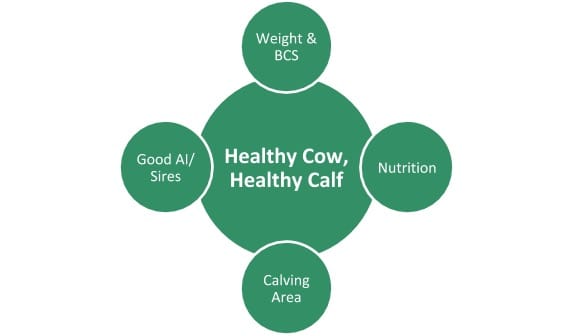
Heifer weight
If you want to earn better profits, your heifers must be able to calve quickly and easily. And calve again. Did you know that live body weights are a good indicator of how well a cow can reproduce?
Mature live weights vary from breed to breed. Ideally, you want your heifers to reach about 30% of their mature weight when they are around six months of age and around 60% of its mature weight around 15 months, during its first mating round.
Finally, you would want your heifers to reach at least 90% of its mature weight by the time it enters the pre-calving stage.
By achieving this 30-60-90 percentage targets, your heifers will:
- Reach puberty earlier
- Get into calving quicker.
- Have less calving difficulties
- Have better fertility as first calvers
- Have higher milk production over their first three lactations
- Last longer in the herd
Also, check if your heifers have large enough pelvic openings, before their first round of mating. Ideally the opening should be around 170 cm2 (i.e. 10 cm x 17 cm = 170 cm2).
However, live weights alone cannot give you enough information about the cow's health. That's why we use BCS in addition to live weights.
Using BCS (body condition scoring)
A visual assessment of how much fat and muscle cover the bones of a cow (scoring focuses on the rump (tail head) and loin). BCS is a measure of a cow’s fat, energy and protein reserves that influences her productivity, reproduction, health, and longevity.
There are at least three different BCS systems, a 9-point system, a 5-point system and the 8-point system followed by Dairy Australia. To learn more about this read: Using BCS to assess the health of dairy cows.
For example, if we take the 8-point BCS system used by Dairy Australia, a score of 1 is given to very feeble animals while a score of 8 is given to excessively fat cows. The scoring method can be applied to all dairy breeds.
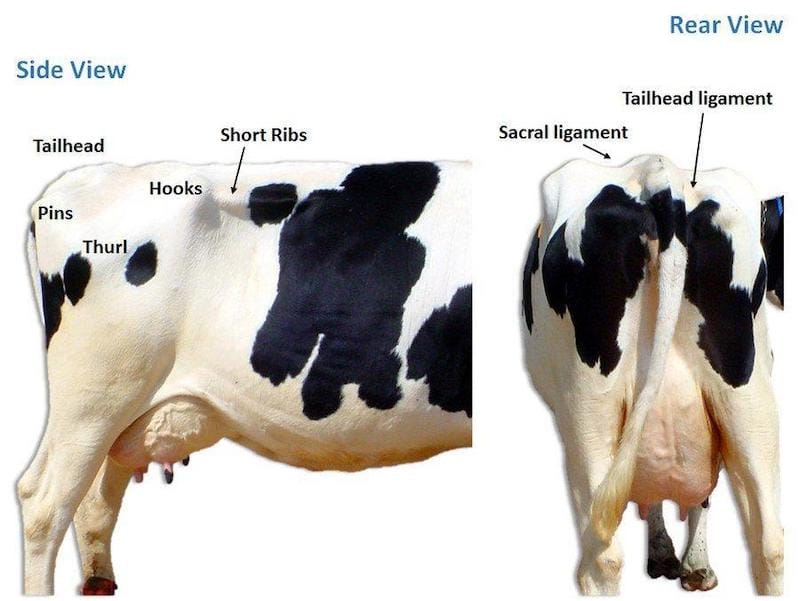
Here are some recommended BCS targets during each stage:
Calving
- Herd average BCS between 4.5–5.5
- < 15% of cows below score 4.5
- < 15% of cows above score 5.5
Mating
- < 0.6 decrease in the average score of the herd since calving
- < 15% of cows lose more than one score since calving
- Cows should maintain or gain body condition after mating
Drying-off
- Herd average BCS between 4.5 and 5.5.
- Cows should maintain or gain body condition during the dry period.
But when it comes to mating, female cows are only one part of the story. You also need to take into account the male sires. Let’s talk about that next.
Selecting sires and using AI
In certain breeds, such as Limousin, Simmental and Charolais, the health and genetic profile of bulls, can play a significant role in calving. Selection of sires can be the difference between an easy or a troublesome delivery.
But in other breeds such as Jersey and Holstein-Friesian, this risk is much lower.
The Calving Ease ABV (Australian Breeding Values) defines the ease by which the bull’s progeny are born – not the ease by which his daughters calve and is given as the percentage of normal or easier calvings in mature cows relative to the average of 100.
- Calving Ease ABV >100 = easier calving
- Calving Ease ABV < 100 = may have difficulty in calving
- Calving Ease ABV of 103 or more = the best bulls in the breed
For more information, check out Good Bulls Guide for profit-based indices and Sire Solutions.
Consider your available infrastructure, production cost, profit targets and genetic requirement when choosing a breeding system.
You could use natural mating, artificial insemination (AI) methods or a combination of both for breeding. When possible, choose an assisted reproduction technique to improve their genetics and their fertility alongside natural mating for your herd.
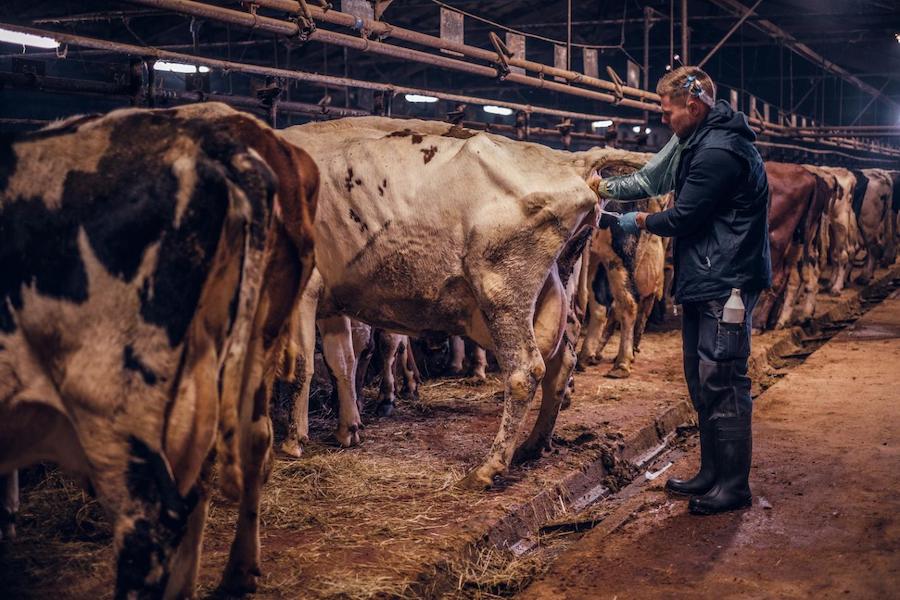
A study by Dr Barry Zimmermann shows that with Australian dairy farmers, only 16% of Australian dairy farmers don’t use any AI options. This probably indicates both the intensive nature of dairy herding and the increasing availability of genomic technologies.
There are both pros and cons to consider when choosing AI over natural mating methods.
Advantages of AI:
- Genetic improvement
- Increased weaning weight of the calf
- More calves born from a single pregnancy
- More herd productivity
- Increased reproductive performance
- Reduce bull costs of procurement and maintenance
Disadvantages of AI:
- More knowledge and management of labour and drug administration
- Increased labour, equipment & facilities and drugs costs
- If variables are not managed, more risk of low pregnancy rates.
On the other hand, while using natural mating methods, your bull management skills play a critical role. Ensure that the selected bulls are well-grown, have adapted well to the local weather conditions, are relatively disease-free and tested for fertility.
Lastly, after insemination or mating, test for pregnancy regularly and maintain records. For more information, refer to Dairy Australia’s InCalf ebook.
Vaccinating your cows
You already know that colostrum is rich in antibodies, growth factors, cytokines, and protects the newborn calf from infections.
But did you know that you can increase the quantities of antibodies in colostrum through an effective vaccination program?
Your cows begin to develop more antibodies in the udder, as early as ten weeks before calving. They also begin to produce colostrum as early as five weeks before calving.
But the cows do not begin to produce colostrum until at least five weeks before calving.
By timing your cow vaccinations, around ten weeks before calving, you can ensure a higher level of antibodies in your cows. This can help you prevent several common newborn calf infections such as E.coli scours, salmonellosis, rotavirus and tetanus.
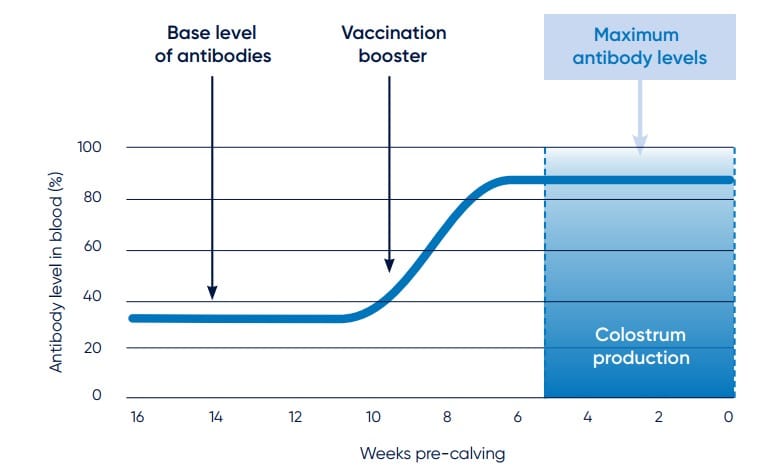
Nutrition before and after calving
The most critical period for your pregnant dairy cows is a six to seven-week window, about a month before calving up to three weeks after calving.
What you feed your cows during the last month, just before calving, plays an essential role in milk production and reproductive performance.
In addition to this, good nutrition during this last leg of pregnancy can help:
- prevent milk fever
- control calving related low blood calcium level disorders, such as ketosis, abomasal displacement, mastitis, retained placenta, uterine infection and ruminal acidosis
- minimise sick and downer cows
- reduce death and culling rates
In addition to good quality pasture or hay, you might want to supplement the diet with some protein and grain concentrates. You could also consider supplementing some anionic salts, micro-nutrients and partially-mixed rations.
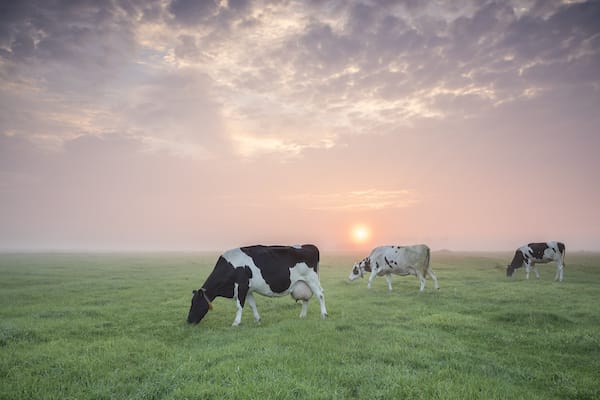
2. Managing Calving environment
Take care taken to provide a clean, well-drained and sheltered calving environment for your cows to deliver healthy newborn calves.
Consider creating several calving areas in advance that have a low stocking rate. Also, take care to ensure that these calving areas aren't wet or full of manure.

Heat stress can reduce dry matter intake and may lead to weight loss in your pregnant cows. In turn, this affects udder development and results in low milk production. Ultimately this affects your calves and your profits. So take the necessary measures to reduce heat stress.
That brings us to the end of pre-calving care. If you liked this, you might also enjoy post-calving care.
If you have any questions, please feel free to ask them as a comment below or check out our growing repository on livestock health. We’ll do our best to answer them for you.
Until we meet again, Happy Farming!
- The Dedicated Team of Pasture.io, 2020-11-06